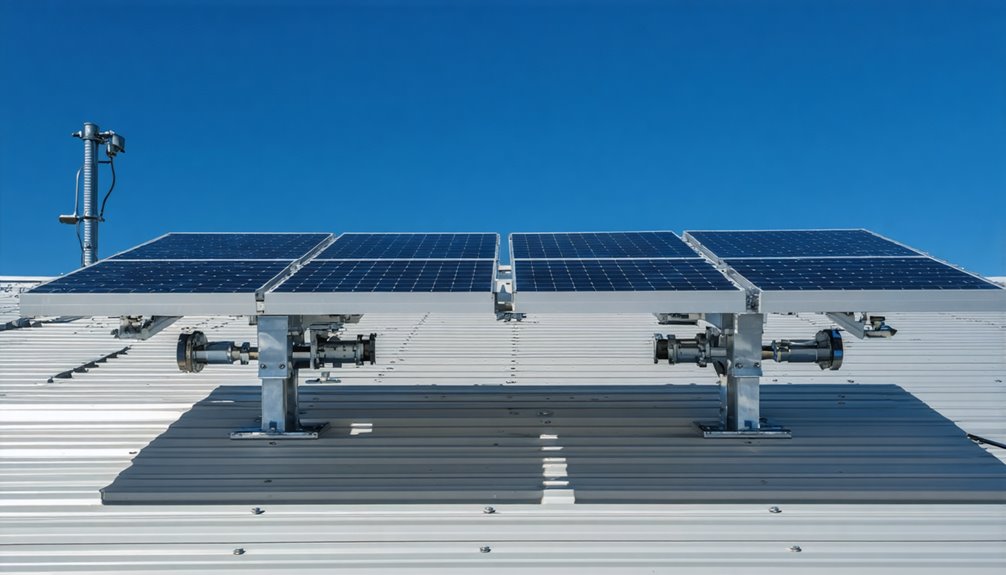You’re watching solar panel technology transform how homeowners capture the sun’s energy. Today’s adjustable mounting systems can tilt from zero to sixty degrees, potentially boosting energy output by twenty percent. Major manufacturers like IronRidge and Unirac now offer mounts that adapt to seasonal sun angles. But there’s a catch that’s making some buyers think twice about these advanced systems.
Key Features of High-Performance Adjustable Solar Mounts
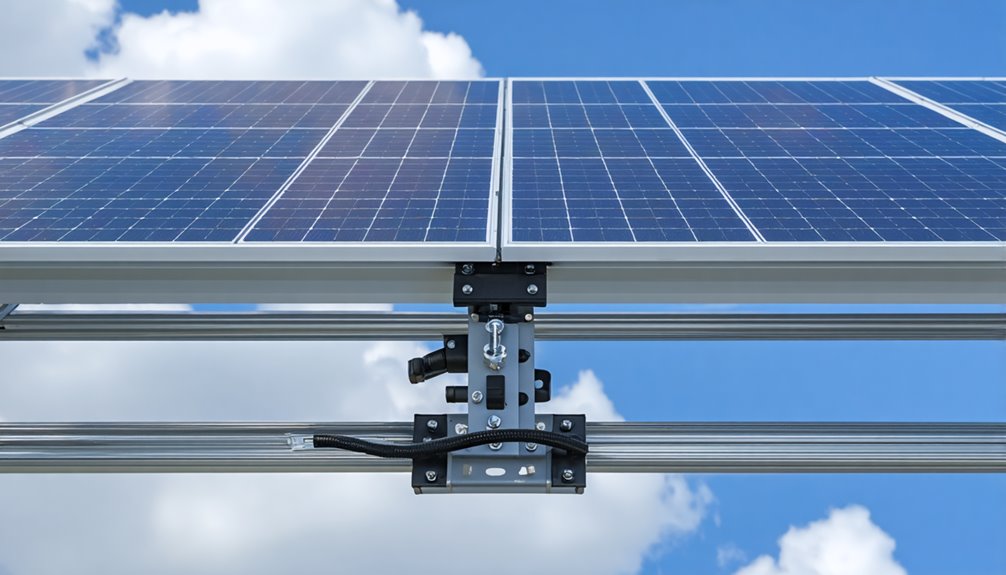
When you’re looking for ways to maximize your solar panel’s efficiency, adjustable mounts offer several key advantages over fixed systems. These mounting solutions let you change panel angles from 0 to 60 degrees. This flexibility can boost power generation by up to 20% on cloudy days.
Manufacturers build adjustable solar mounts with corrosion-resistant materials. They’ll last through rain, snow, and harsh weather. The mounts come with pre-drilled holes and hardware kits that make installation straightforward for both professionals and DIY users. The best mounting brackets combine weather resistance with structural integrity to ensure decades of reliable performance in any climate.
These versatile mounts work with different panel sizes. You can use them on roofs, walls, RVs, and off-grid setups. Some advanced models even track the sun’s movement throughout the day. These tracking systems can increase energy output by 35% compared to fixed panels, helping you meet your energy needs more effectively.
Top Benefits of Using Adjustable Solar Panel Mounting Systems
Whether you’re using solar panels at home or on the road, adjustable mounting systems deliver major advantages over fixed installations. You’ll boost power generation by up to 20% on cloudy days thanks to angle adjustments between 0-60 degrees. An adjustable solar panel mount lets you reposition panels based on seasons and time of day to maximize sunlight exposure year-round.
You’ll find these systems work with different panel sizes and brands, making solar panel mounting flexible for roofs, RVs, and off-grid setups. The proper equipment includes corrosion-resistant materials that last longer in harsh weather. You’ll save money on labor costs since pre-drilled holes and complete hardware make installation faster than traditional fixed mounts. While ground and pole installations offer excellent adjustability for maximizing energy efficiency, roof-mounted systems remain popular for residential applications due to space constraints.
Best Adjustable Mount Brands for Residential Solar Installations
Two major brands dominate the residential solar mounting market with their adjustable systems. IronRidge offers the XR rail series for pitched roofs. It’s known for strong and reliable solar panel installation solutions. Unirac specializes in adjustable mounts for flat roofs. You can adjust each panel’s angle independently with their system.
Both brands meet high durability standards. Their components withstand various weather conditions. This durability matters for residential settings. Adjustable mounts can boost solar efficiency by up to 20% on cloudy days. That’s why these angle adjustment features are valuable for homeowners.
Licensed installers know these brands well. They’ll guarantee the mounting systems work with your specific roof conditions. Both IronRidge and Unirac have proven track records in residential solar installations. Their systems undergo rigorous wind and snow load testing to ensure reliability across diverse climate conditions.
Angle Adjustment Ranges and Optimal Positioning Guidelines
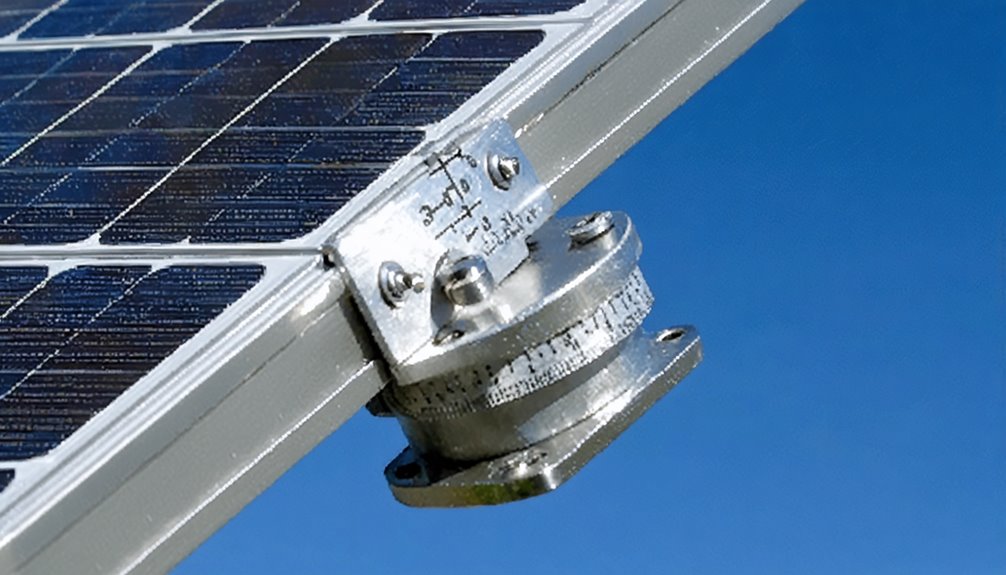
Most adjustable solar panel mounts let you tilt your panels between 0 and 60 degrees. This angle adjustment feature helps you capture more sunlight throughout the year. You’ll see up to 20% more energy generation on cloudy days when you’ve positioned your panels correctly.
Here’s how ideal positioning changes with the seasons:
| Season | Recommended Angle | Benefit |
|---|---|---|
| Winter | Latitude minus 15° | Better low sun capture |
| Summer | Equal to latitude | Maximum overhead exposure |
| Spring | Latitude minus 5° | Balanced performance |
| Fall | Latitude plus 10° | Extended daylight harvest |
When you’re using adjustable solar panel mounts, you can change angles during peak sun hours. This flexibility makes cleaning and snow removal easier too. Many homeowners don’t realize how much these adjustments boost their system’s performance until they start tracking their energy output.
Material Durability and Weather Resistance Considerations
Your adjustable solar panel mounts face rain, snow, wind, and scorching sun every single day. That’s why manufacturers build them from rust-free aluminum and other corrosion-resistant metals. These materials won’t break down when exposed to harsh weather conditions.
The material durability of these mounts really matters. They’re designed to handle extreme weather, including high winds and heavy snow loads. Engineers test them to confirm they’ll last for decades outdoors.
Weather resistance features include waterproof seals that keep moisture out. UV-stabilized parts won’t crack or fade in the sun. Many adjustable mounts also have special coatings that prevent rust and corrosion.
Pre-drilled holes and strong fastening systems help the mounts stay secure during storms. These design choices guarantee your panels won’t move during severe weather events.
Installation Methods for DIY and Professional Applications
When homeowners decide to install adjustable solar panel mounts, they’ll find the process simpler than expected. These mounting system units come with pre-drilled holes and all necessary hardware. DIY enthusiasts can install solar panels themselves using the included screws and bolts.
Professional installers take a different approach. They’ll check your roof’s condition and orientation before starting. They determine which mounting solutions work best for maximum energy production. They also make sure installations follow local building codes.
Some homeowners can’t use roof-mounted systems. They might have limited roof space or wrong roof angles. Ground-mounted adjustable solar panel mounts offer a solution. These systems let you position panels anywhere on your property. They’re also easier to maintain than roof installations. Ground-mounted systems allow for optimal tilt angles that maximize solar energy capture throughout the year, regardless of your roof’s fixed pitch.
Cost Analysis of Adjustable Vs Fixed Solar Mounting Systems
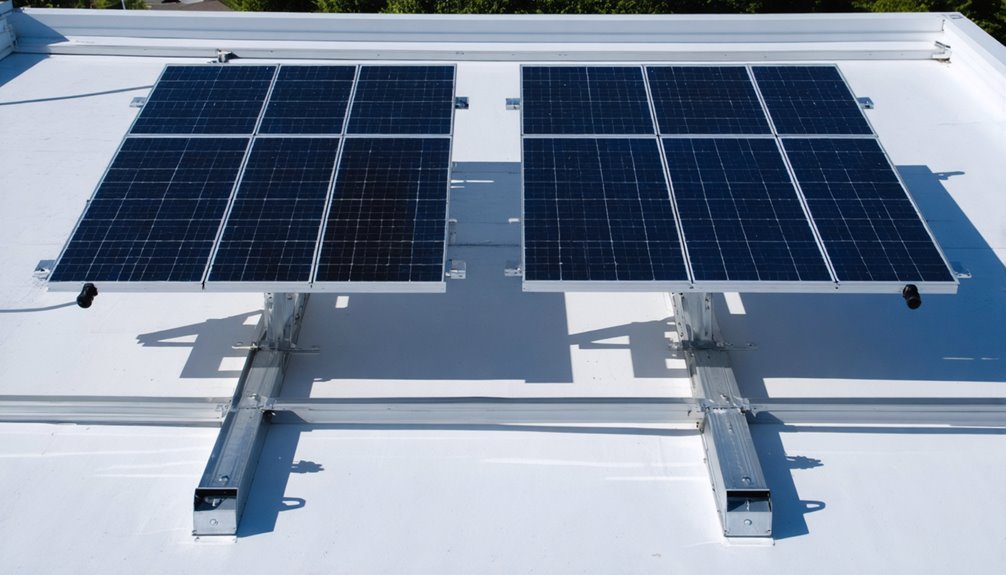
Although adjustable solar panel mounts cost more upfront, they’ll produce more energy than fixed systems. The price difference ranges from $0.50 to $2.00 per watt. That’s a significant investment, but adjustable systems can increase energy production by up to 20%.
| Feature | Adjustable Systems | Fixed Mounts |
|---|---|---|
| Initial Cost | Higher | Lower |
| Energy Output | 20% More | Standard |
| Long-term Savings | Better | Limited |
The cost analysis shows adjustable systems require more money at first. You’ll pay extra for installation too. However, these systems generate more electricity over time. Fixed mounts can’t match their efficiency, especially during cloudy weather. The increased energy production often makes up for the higher initial expense. Many homeowners find the investment worthwhile. Tracking systems automatically follow the sun’s path throughout the day, maximizing energy capture beyond what manual adjustable mounts can achieve.
Compatibility Factors for Different Solar Panel Sizes and Brands
Before selecting adjustable mounts, you’ll need to check if they fit your solar panels. Most adjustable solar panel mounts work with panels measuring around 13.8 inches, but compatibility varies by brand.
You’ll find that many mounts require drilling to match your panel’s measurements. Popular models like Voltset’s 30W and 50W panels fit various mount types. Pre-drilled holes make setup easier for DIY users who own different panel brands.
When mounts and panels match correctly, you’ll see better solar efficiency. Proper brackets let panels rotate from 0 to 60 degrees. This rotation helps panels catch more sunlight throughout the day. Manufacturers include hardware that fits multiple panel sizes, making these mounts versatile for off-grid projects. For flat roof installations, ballast mount systems offer an alternative that doesn’t require drilling and uses weighted blocks to secure panels safely.
Ground-Based Vs Roof-Mounted Adjustable Systems Comparison
The choice between ground-based and roof-mounted adjustable systems affects your solar panel’s performance and maintenance needs.
Ground mounts let you position panels perfectly for maximum solar energy capture. They’re not limited by roof angles or shade from trees. You’ll find maintenance easier since you can reach panels without climbing. These systems work great if your property has poor roof orientation.
Roof mounts use your existing structure, which can save money. However, you’ll need to check if your roof’s strong enough and facing the right direction. Installation takes longer because workers must follow safety rules and seal everything to prevent leaks.
Both types offer adjustable angle capabilities that can boost energy production by up to 20% when clouds roll in. This feature helps you capture more power throughout the day. Advanced models incorporate tracking mount systems that automatically follow the sun’s path, potentially increasing power generation by 25-40% compared to fixed installations.
Maintenance Requirements and Long-Term Performance Expectations
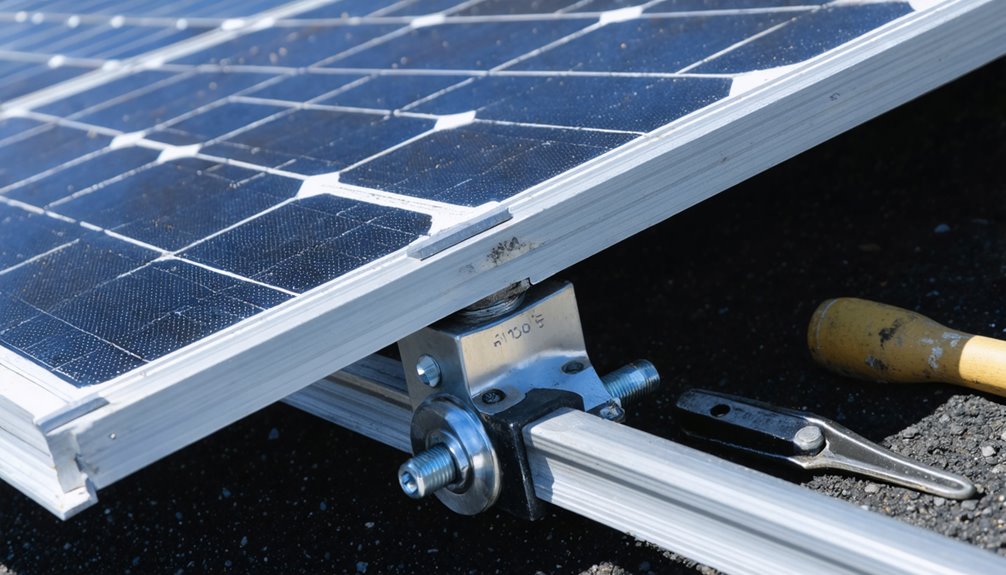
When you own adjustable solar panel mounts, you’ll need to check them throughout the year to guarantee they’re working properly. Your maintenance tasks will include inspecting for rust and damage during each season, replacing worn parts based on manufacturer timelines, and preparing the system before harsh weather hits. Most quality mounts are built to last 25 years or more, but they’ll only reach that lifespan if you follow regular upkeep schedules.
Seasonal Inspection Schedule
As you maintain your adjustable solar panel mounts throughout the year, you’ll need to follow a regular inspection schedule. Experts recommend seasonal inspections to check mounting brackets and fasteners. These components must stay secure and undamaged for proper solar tracking.
You should clean panels at least twice yearly. Dirt and debris can cut efficiency by up to 20%. Heavy storms or seasonal changes often leave panels especially dirty.
During inspections, you’ll want to verify the angle adjustability of your mounts. Sun positions change with seasons, and adjustments help capture maximum energy. You should also check metal parts for rust or corrosion annually. These problems can weaken mounting systems over time.
Weather monitoring helps you spot risks early. This leads to timely maintenance that keeps your system running well.
Component Replacement Timeline
Even though your solar panel mounts seem sturdy, they’ll need component replacements at specific intervals. You’ll find that fasteners require replacement within five years of installation. This maintains your solar mounting system’s structural integrity and safety.
Your panel racking undergoes constant stress from weather conditions. That’s why manufacturers recommend a complete system evaluation every three to five years. During these checks, technicians assess all racking components for wear and damage.
Weather-resistant materials make a significant difference in longevity. Anodized aluminum and stainless steel components can last up to 25 years with proper maintenance. These materials resist corrosion and degradation better than standard options.
Component replacement isn’t just about fixing broken parts. It’s about preventing failures before they occur. Regular replacements guarantee your adjustable mounts continue operating at peak efficiency year-round.
Weather Impact Mitigation
Because weather conditions constantly challenge your solar panel mounts, you’ll need regular maintenance to protect your investment. You’ll find that adjustable solar panel mounts require routine inspections for rust and loose connections, especially after storms. Manufacturers now use corrosion-resistant materials like anodized aluminum and stainless steel to help installations last longer in harsh climates.
You’ll maintain energy production efficiency by adjusting mount angles seasonally and cleaning panels regularly. Debris buildup can block sunlight and reduce power output. Most quality mounts come with warranty programs that cover performance standards for weather impacts.
Regular maintenance tasks include checking connections before high winds and clearing snow loads in winter. These simple steps help guarantee your solar system continues producing power effectively through all weather conditions.
Conclusion
You’ll find adjustable solar panel mounts from companies like IronRidge and Unirac can boost your energy output by up to 20%. These systems let you change panel angles from 0 to 60 degrees throughout the year. They’re built to handle tough weather conditions. While they cost more upfront than fixed mounts, the extra energy they produce often makes them worthwhile. Regular maintenance keeps these adjustable systems working well for years.

